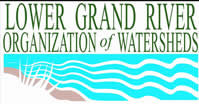Lower Grand Watershed Interactive Tool (WIT) - Petroleum By-Products

Petroleum and petroleum by-products (oil and grease) are urban pollutants that are transported by rainfall from roads, parking lots, and improper storm drains.
Petroleum, natural gas, coal, and bitumens contain compounds called hydrocarbons. Hydrocarbons are defined as an organic compound (as acetylene or butane) containing only carbon and hydrogen. The presence of hydrocarbons is often the result of road runoff containing automotive petroleum products. It may also result from illicit dumping of used motor oil into storm drains. Industrial and fuel storage sites can also contribute hydrocarbons to surface water and groundwater.
What are the Effects of Petroleum and/or Petroleum By-Products? (1)
- Volatile organic hydrocarbons in oil immediately kill a number of aquatic organisms, especially in their vulnerable larval forms.
- Some other chemicals form tar-like globs that float on the surface. This floating oil coats the feathers of birds, and the fur of marine mammals, destroying the animals' natural insulation and buoyancy; many drown or die of exposure from loss of body heat.
- Heavy oil components that sink to the ocean floor or wash into estuaries can smother bottom-dwelling organisms such as crabs, oysters, mussels, and clams or make them unfit for human consumption.
Facts about Hydrocarbons (2)
- Hydrocarbons are only degraded in water.
- Bacteria and fungi do not grow in hydrocarbons, they grow on water in or surrounding the hydrocarbons.
- All hydrocarbons are soluble to some extent.
- This is why the process of degradation is able to start and then continue. Without the presence of water, oil is not degraded.
- A thick layer of crude oil on the surface of water will take up about 50% water by weight and remain a free-flowing, oily liquid.
How are Hydrocarbons broken down?
Many types of microorganisms can degrade hydrocarbons. Bacteria, yeasts, and filamentous fungi all have taxa that degrade some types of hydrocarbon molecules.
- Bacteria - The heterotrophic bacteria utilize carbon from the hydrocarbons as a source of carbon and energy for biomass production. There are many genera of bacteria which carry out these reactions on different hydrocarbons.
- Fungi - Many yeasts are active in soils and water systems in hydrocarbon degradation, as are some very common genera of mycelial fungi such as Trichoderma, Aspergillus and Cladosponum.
Sources:
(1) Miller, G. Tyler Jr. 2002. Living in the Environment 11th edition. Brooks/Cole Publishing Company. pg 546. (2) University of Waterloo. Environmental Microbiology 447. "
Module 5. Hydrocarbons" Canada. 10/7/2002.
